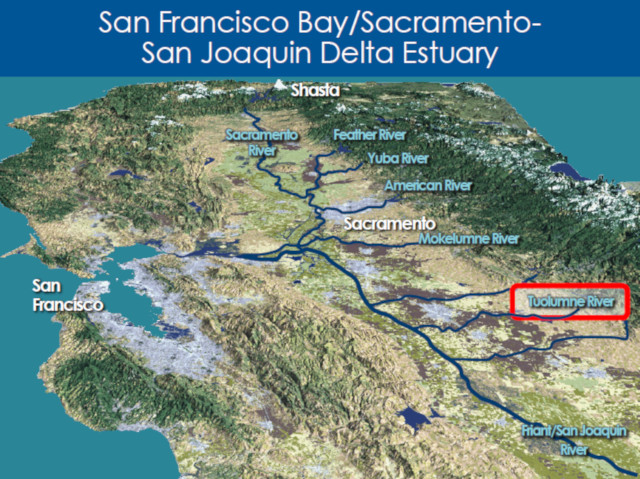Sacramento, CA…The State Water Resources Control Board on December 12th adopted a plan designed to restore water flows through the Lower San Joaquin River and its tributaries—the Stanislaus, Tuolumne and Merced rivers. The plan update the Board adopted includes a requirement for 40 percent of unimpaired flow, within a range of 30 to 50 percent. Some fear they pushed the vote back to after the November Elections and Fire Season to lesson the political “Fish over People” outcry over the plan. It is uncertain what the potential impacts to the Governor’s, State Assembly, State Senate or House of Representatives races would have been or if the impacts would have been enough to change the outcomes. If they had voted on this plan in October as scheduled it probably would have at least changed the outcome of the Jeff Denham vs Josh Harder race in the agricultural water centric 10th District.

The plan sets a starting point for increased flows but also makes allowances for reduced river flows on tributaries where stakeholders have reached voluntary agreements to pursue a combination of flow and “non-flow” measures that improve conditions for fish and wildlife, such as habitat restoration and reducing predation.
“Californians want a healthy environment, healthy agriculture, and healthy communities, not one at the undue expense of the others,” said State Water Board Chair Felicia Marcus. “Doing that requires that the water wars yield to collective efforts to help fish and wildlife through voluntary action, which the plan seeks to reward. The collaborative spirit we heard today offers promise and motivation towards that goal.”
The Board’s action followed testimony by leaders of the Department of Water Resources and the Department of Fish and Wildlife that significant progress has been made among stakeholders to reach voluntary agreements on the Tuolumne River and tributaries of the Sacramento River. The Board postponed a decision last month to allow time for discussions to yield results.
The Board directed staff to work with the parties to evaluate the proposals involving the Tuolumne River and Sacramento River watershed and consider them as part of a comprehensive analysis of the Delta watershed during 2019.
The future actions by the Board would follow a public process and would need to find that the agreements reasonably protect uses of the Delta watershed’s waters.
The Board has repeatedly emphasized that voluntary agreements can provide a faster, more durable solution to reasonably protect beneficial uses in the Lower San Joaquin River and its tributaries, while also recognizing the necessity of taking timely action.
Approval of the Bay-Delta Water Quality Control Plan update for the Lower San Joaquin River and Southern Delta, and an accompanying Substitute Environmental Document, follows a nine-year process during which the Board studied and analyzed options, and conducted one of the most extensive public outreach efforts in its history.
The State Water Board is also progressing with its effort to update flow requirements for the Sacramento River, its tributaries, and the Delta and its tributaries — including the Feather, Yuba and American rivers. This update is at an earlier stage of development than the Lower San Joaquin River/Southern Delta plan update; a draft proposed plan and staff report analyzing alternatives will be released later this year for public review and comment.
The two Bay-Delta Plan updates are part of a delicate balancing act aimed at addressing an ecological crisis in the Delta and preventing further collapse of Bay-Delta fisheries while considering the many other vital water uses for millions of Californians.
A dramatic decline in the once-thriving populations of native fish species that migrate through and inhabit the Delta has brought some species to the brink of extinction. In 1984, for example, about 70,000 fall-run Chinook salmon adults returned to the San Joaquin Basin. The number of returning adults dropped to 40,000 in 2010 and just 10,000 in 2016 and 2017.
While multiple factors contributed to the decline, the magnitude of diversions out of the Sacramento, San Joaquin, and other rivers feeding into the Bay-Delta is a major reason for the ecosystem decline. Currently, flows remaining in the San Joaquin River and its three tributaries can run as low as 6 percent in dry or drought years, while they average 10 to 20 percent of unimpaired flow at critical times of the year and range from 21 to 40 percent on average.
The final Lower San Joaquin River/Southern Delta update includes improved instream flows February through June, the critical months for migrating fish on the Stanislaus, Tuolumne and Merced rivers. These flows are measured as a percentage of “unimpaired flow,” the amount of water moving down river if there were no dams or other diversions.
A flow criteria report adopted by the State Water Board in 2010 concluded that an unimpaired flow requirement of 60 percent on the Lower San Joaquin River would be desirable to preserve the attributes of a natural variable system to which native fish species are adapted. That report did not consider impacts to other water users, however, which the Board has done in arriving at a lower flow requirement.
The plan update the Board adopted includes a requirement for 40 percent of unimpaired flow, within a range of 30 to 50 percent. The Board’s proposal seeks to incentivize agreements that offer habitat restoration and other measures that can benefit fish and wildlife with less water, than just water alone.
The update also includes a revision of the salinity standard for the southern Delta. Maintaining an adequate amount of fresh water in the southern Delta is critical to protecting agriculture in the region. The year-round salinity standard in the draft final update increases slightly from the current seasonal standards, while continuing to provide water quality needed to support a vibrant agricultural future for the Delta.
#


